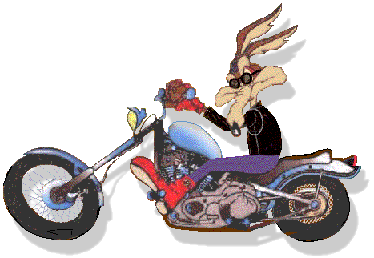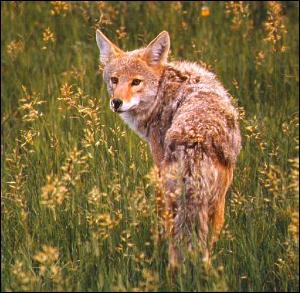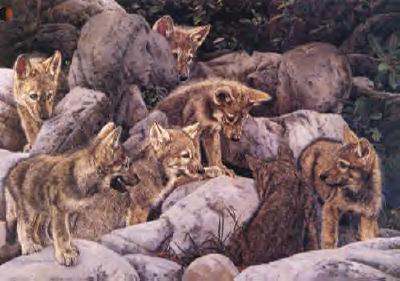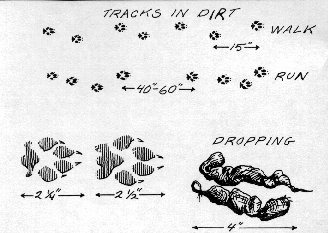|
|
THE BLUEBIRD, THE COYOTE & THE MAGIC LAKE Long, long ago, Bluebird was drab and ugly -- not the beautiful blue color he is now.
One night Dream Spirit spoke to him in a dream. He told Bluebird how he could change his color. Far away in the
mountains, said Dream Spirit, is a magic lake of beautiful blue water. The lake has no inlet and no outlet, so
the water is always the same deep blue color. "Go to the blue lake," said the Dream Spirit, "and bathe in the waters
four times each morning until the fifth morning. The Dream Spirit also told Blue bird, "while you bathe you must sing this song"
I went in, I went in So Bluebird went into the lake of blue water and did everything exactly as Dream Spirit
told him to do. On the fourth morning all his feathers dropped off, and Bluebird came out of the water perfectly
naked. On the fifth morning, as he began to bathe and sing, new feathers started to grow.
By the time Bluebird had finished his bath, he was completely covered with a beautiful new set of fine blue feathers,
which he has worn ever since. Now Coyote was bright green in those days. He had been hiding in the grass all this
time, waiting for a chance to catch Bluebird and eat him. But on the fifth morning he forgot all about his hunger.
For he saw Bluebird, who was wearing a beautiful new blue coat, fly from the lake and alight in the tree above
him. Blue was Coyote's favorite color, so he looked up and said, "How is this, Bluebird?
You were so ugly, and now you wear a beautiful blue coat. Tell me how you changed yourself, so I can do the same." Bluebird told Coyote what to do and taught him the song to sing. Then Coyote went to
the lake and bathed and sang the song as he had been told to do.
I went in, I went in When he finished he was as blue as the bluebird! Coyote was very proud of his new blue coat. He thought he was the most beautiful animal
in the world, and he wanted everyone else to see and admire him too. He began to trot along the mountain path,
calling to everyone, "See me! I am Coyote! I have changed my color. I am now a beautiful blue." As Coyote trotted along, he turned his head first one way and then the other way to
look at himself, thinking all the time how fine it was to be such a beautiful color and how beautiful he now was.
He wished for all the animals to admire him. Then, without stopping, he looked back at his shadow to see if it was also blue. Of
course, by not watching where he was going, Coyote ran right into a rock. He struck it so hard that he was knocked
down flat and went rolling over and over down the dusty hillside. When he got to his feet again he was gray with
dust, and his beautiful blue color was all Coyote could never shake off the dust. He has been dirty gray ever since. It is said
that this was Dream Spirit's way of punishing Coyote for being so vain and foolish. Since then, the magic lake where Dream Spirit told Bluebird to bathe can no longer
be found. Bluebird is still a beautiful blue color and Coyote will forever be dirty gray because of his vanity.
COYOTE Coyote Study The Coyote
Paraphrased by Little Jumper, from the book Indian Campfire Tales by W.S. Phillips

It is blue water, it is blue,
It is blue water, it is blue.
I am now blue,
I am now blue.


It is blue water, it is blue,
It is blue water, it is blue.
I am now blue,
I am now blue.

gone!
 THE SPECIES: Canis latrans incolatus
THE SPECIES: Canis latrans incolatus
Tough and crafty, this wild relative of the common dog adapts masterfully to new environments. Coyotes were once
creatures solely of the southern plains but today they thrive from the tropical heat of Costa Rica to the chilling
arctic winds of the Yukon. Opportunists par excellence, they mold their lifestyle and diet to fit new surroundings
with remarkable ease.
DISTRIBUTION
Coyotes are animals of the fringe. That is, they flourish in areas where two or more habitats meet and diversity
of prey is high. Riversides, forest burns, and farmland are all likely homes for the coyote. Being opportunists,
they are also scavengers and will often live close to our communities.
CHARACTERISTICS
In spite of a delicate body build, coyotes are often confused with wolves. Coyotes range in weight from 9 to 13
kilograms which is less than half the size of a wolf. The large sharply pointed ears, long slender snout, and bushy
tail are all traits of the coyote. Another difference is the position of the tail. The coyote's hangs down, sometimes
tucked slightly between the legs while the wolf's is held out level with its back.
 LIFE HISTORY
LIFE HISTORY
Coyote pairs mate in late February or early March. Although not necessarily paired for life, a mating couple may
remain together for a number of years. By early April, the pregnant female prepares for her litter by seeking a
den site. She prefers to enlarge an existing ground squirrel hole or use a natural cavity rather than dig a new
den. When she's finished, the den will be about one meter in diameter. To defend against attacks on her young,
the female will either devise a second hidden escape route or ensure there are other burrows nearby. Coyote pups
provide a tender meal for wolves, bears and even golden eagles.
It is within the earthen den, during early May, that the young pups are born. Little bedding protects them from
the damp earth and with eyes closed until 9 days, they look a vulnerable sight. But they develop rapidly. Nourished
by their mother's milk, their fine brown fur becomes a thick coat and in less then two weeks they are peeking out
of the den's entrance. By five weeks of age, they are eating the half digested snowshoe hare their parents provide.
An average litter size of 5 - 7 pups keeps both parents busy hunting for whatever they can catch or scavenge.
Near the end of two months the hunting lessons have begun. The young are natural hunters. Whether they are after
a dinner of ground squirrels, mice, beetles, or bird's eggs, their cleverness pays off. Coyotes have a distinctive
hunting technique. Once prey is spotted, a coyote will stalk slowly and silently until finally it springs up and
pounces stiff-legged onto the unsuspecting animal. The young's hunting abilities must be finely tuned by summer's
end when the crisp autumn winds signal the break up of the family unit.
In some winters, a family unit may stay together to increase hunting efficiency. This is done if the winter is
particularly lean or if the main food source is a large animal like the deer. Just as soon as the snow's crust
is hard enough in open areas, coyotes return to roaming freely. But even then, they will tailor their movements
to take advantage of snowshoe hare trails or other areas of compact snow.
COYOTES AND PEOPLE
Although often associated with populated areas, the coyote is timid and wary of people. Trappers recount numerous
stories of the coyote's remarkable ability to outwit humans. They are indeed a hard animal to trap, perhaps because
they are so familiar with human scent. Trappers will attract coyotes by rubbing urine from a different coyote over
the trap.
Coyote fur is coarser than the fur of many animals. It stands up well to use. Because of its low price and good
serviceability, coyote fur is commonly used as parka trim.
 VIEWING OPPORTUNITIES
VIEWING OPPORTUNITIES
Strangely enough, if you're eager to view a coyote you have a better chance near a community than in remote areas.
Coyotes are active at night and can often be spotted along back roads or in the suburbs by those who rise at first
light. If you are lucky, you might see one lazing in the early morning spring sunshine when the days start to lengthen.
As with all wildlife, coyotes can be dangerous, so avoid approaching.
Coyotes are heard as often as they're seen. A chorus of whines, barks, and howls drifting into the late evening
or early morning air is sign of their presence. The exuberant cry of one coyote is often joined by the yips and
yaps of other family members.
http://bluebullets.knox.k12.il.us/RMES/CoyoteProject/coyote.html
http://www.voicenet.net/~srussell/coyote.html
![]()
|
|
| Canku Ota is a free Newsletter celebrating Native America, its traditions and accomplishments . We do not provide subscriber or visitor names to anyone. Some articles presented in Canku Ota may contain copyright material. We have received appropriate permissions for republishing any articles. Material appearing here is distributed without profit or monetary gain to those who have expressed an interest. This is in accordance with Title 17 U.S.C. section 107. |
|
Canku Ota is a copyright of Vicki Lockard and Paul Barry. |
|